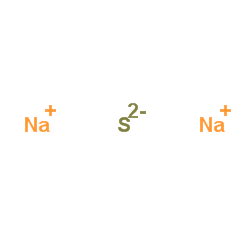Sodium sulfide

Sodium sulfide structure
|
Common Name | Sodium sulfide | ||
|---|---|---|---|---|
| CAS Number | 1313-82-2 | Molecular Weight | 78.045 | |
| Density | 1.86 g/mL at 25 °C(lit.) | Boiling Point | 174ºC | |
| Molecular Formula | Na2S | Melting Point | 950 °C(lit.) | |
| MSDS | Chinese USA | Flash Point | N/A | |
| Symbol |




GHS02, GHS05, GHS06, GHS09 |
Signal Word | Danger | |
|
Abiogenic Syntheses of Lipoamino Acids and Lipopeptides and their Prebiotic Significance.
Orig. Life Evol. Biosph. 45 , 427-37, (2015) Researchers have formed peptide bonds under a variety of presumed prebiotic conditions. Here it is proposed that these same conditions would have also formed amide bonds between fatty acids and amino acids, producing phosphate-free amphipathic lipoamino acids... |
|
|
Determination of ethanol using permanganate-CdS quantum dot chemiluminescence system.
Luminescence 30 , 660-7, (2015) A novel and highly sensitive chemiluminescence (CL) method for the determination of ethanol was developed based on the CdS quantum dots (QDs)-permanganate system. It was found that KMnO4 could directly oxidize CdS QDs in acidic media resulting in relatively h... |
|
|
Sensitive naked eye detection of hydrogen sulfide and nitric oxide by aza-BODIPY dyes in aqueous medium.
Anal. Chem. 86(18) , 9335-42, (2014) With an objective to develop optical probes for biologically important anions and neutral molecules, we synthesized three novel NIR absorbing aza-BODIPY derivatives, 3a-3c, and have systematically tuned their photophysical properties by changing the periphera... |
|
|
Macromolecular Systems with MSA-Capped CdTe and CdTe/ZnS Core/Shell Quantum Dots as Superselective and Ultrasensitive Optical Sensors for Picric Acid Explosive.
ACS Appl. Mater. Interfaces 7 , 24778-90, (2015) This work reports the development of highly fluorescent materials for the selective and efficient detection of picric acid explosive in the nanomolar range by fluorescence quenching phenomenon. Poly(vinyl alcohol) grafted polyaniline (PPA) and its nanocomposi... |
|
|
Water-soluble nanoconjugates of quantum dot-chitosan-antibody for in vitro detection of cancer cells based on "enzyme-free" fluoroimmunoassay.
Mater. Sci. Eng. C. Mater. Biol. Appl. 52 , 61-71, (2015) Cancer remains one of the world's most devastating diseases with millions of fatalities and new cases every year. In this work, we attempted to develop a facile "enzyme-free" fluoroimmunoassay based on the novel nanoconjugates composed of CdS quantum dots (QD... |
|
|
Fabrication of Mesoporous CoS2 Nanotube Arrays as the Counter Electrodes of Dye-Sensitized Solar Cells.
Chem. Asian J. 10 , 1932-9, (2015) Mesoporous cobalt sulfide nanotube arrays on FTO-coated glass were synthesized by combining three simple technologies: the selective etching of ZnO sacrificial templates, mesoporous Co3 O4 formation from cobalt-chelated chitosan, and ion-exchange reaction (IE... |
|
|
Patterning fluorescent quantum dot nanocomposites by reactive inkjet printing.
Small 11(14) , 1649-54, (2015) Fluorescent quantum dot nanocomposites, including polymer and photonic crystal quantum dots, have been fabricated by reactive inkjet printing. This reactive inkjet printing method has the potential to be broadened to fabrication of other functional nanomateri... |
|
|
Highly luminescent and cytocompatible cationic Ag2S NIR-emitting quantum dots for optical imaging and gene transfection.
Nanoscale 7 , 11352-62, (2015) The development of non-toxic theranostic nanoparticles capable of delivering a therapeutic cargo and providing a means for diagnosis is one of the most challenging tasks in nano-biotechnology. Gene therapy is a very important mode of therapy and polyethylenei... |
|
|
Effect of hot-water extraction (HWE) severity on bleached pulp based biorefinery performance of eucalyptus during the HWE-Kraft-ECF bleaching process.
Bioresour. Technol. 181 , 183-90, (2015) The effectiveness of a biorefinery based on an HWE-Kraft-ECF bleaching process and the end use of pulp was systematically evaluated. Using a P-factor of 198, nearly 30% of xylan-based sugars were recovered. The resulting pulp and paper properties were found t... |
|
|
Reducing Environmental Toxicity of Silver Nanoparticles through Shape Control.
Environ. Sci. Technol. 49 , 10093-8, (2015) The use of antibacterial silver nanomaterials in consumer products ranging from textiles to toys has given rise to concerns over their environmental toxicity. These materials, primarily nanoparticles, have been shown to be toxic to a wide range of organisms; ... |